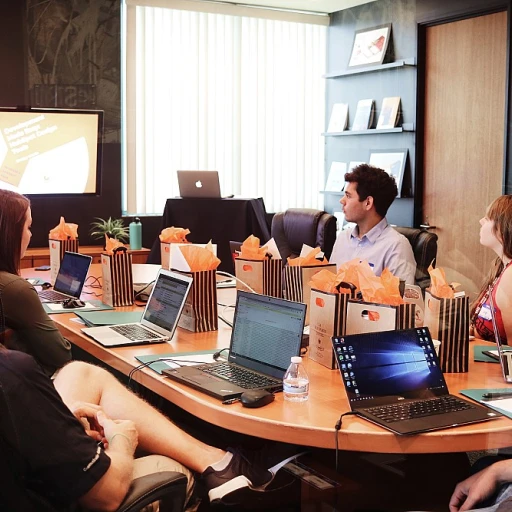
Defining Guild and Upskill
Understanding the Concepts of Guilds and Upskilling
In the rapidly evolving landscape of workforce development, two primary concepts frequently mentioned are 'guild' and 'upskilling'. Both play significant roles in helping companies and employees navigate the challenges of the modern job market by focusing on advancing skills and capabilities. Guilds have been around for centuries, originating as associations of craftsmen or merchants who guided the professional development of their members. In the contemporary context, guild education refers to structured programs provided by employer partners, designed to enhance the skills of their workforce, often including elements like tuition assistance and specialized training infrastructure. Guilds form partnerships between a company and education providers to deliver high-quality education and learning programs for employees, and play a key role in talent development and career mobility. Conversely, upskilling is a more individualized approach focused on expanding an employee’s existing skill set. It's a critical component of human resources strategies aiming to bridge the skills gap in various industries. Through upskilling programs, employers invest in training that helps working adults, often with education benefits like learning development courses, to adapt to new technologies, move into higher roles, or shift into new domains such as data analytics. This continuous ability to adapt and learn is essential in maintaining career relevance and achieving company goals. Recognizing the distinct purposes and practices in guilds and upskilling is vital for employees and employers alike, as it affects decisions regarding workforce management, program implementation, and career trajectory. For those intrigued about bridging the gap between the existing and desired skills, more insights can be found in effective reskilling strategies.Historical Context and Evolution
The Evolutionary Path That Brought Us Here
The evolution of reskilling has been a journey deeply intertwined with the historical context of work and education. We see this most prominently in the traditional structure of guilds and the modern concept of upskilling.
Guilds date back to the Middle Ages, when crafting and trade dictated the economy. They acted as a structured network, allowing artisans and craftsmen to pass skills from masters to apprentices in a systematic, albeit time-intensive, manner. This network mirrored early forms of what we might today call formal education. In modern industries, the approach of guild education can be seen in how companies establish comprehensive training programs for employees. These are often supported by employer partnerships and tuition assistance, ensuring a continuous learning development. They focus on structured learning paths that help employees accumulate high-quality skills.
On the other hand, upskilling is a more recent development, coming into the spotlight as the need for constant adaptation increased due to technology and globalization. Now, it's about enabling employees to swiftly acquire new skills and improve their career mobility. Upskilling programs involve flexible learning solutions that accommodate working adults, offering more individualized approaches thanks to digital learning platforms.
Moreover, the contemporary job landscape has expanded the ways in which employers can support education career progression. Thanks to new technological tools, such as data analytics and the emergence of a learning marketplace, organizations can tailor their reskilling upskilling efforts to meet specific industry demands. This shift has allowed employers to strategically manage their workforce, ensuring they have the right talent equipped with future-proof skills.
For those interested in a deeper dive into this transformative journey of reskilling, it's all about navigating effectively. Learn more about the path to reskilling in project management, which touches upon various aspects of upskilling reskilling initiatives.
Benefits of Guilds in Reskilling
The Role of Guilds in Professional Reskilling
Guilds have historically been centers for learning and skill development, providing a structured path for career advancement. This tradition is making a resounding comeback in the modern workforce, serving as valuable vehicles for employees seeking to advance their careers through comprehensive reskilling and upskilling initiatives. Guilds offer multiple benefits in reskilling:- Structured Learning and Development Programs: With a focus on high-quality training, these programs often collaborate with employer partners, creating a tailored educational experience for working adults. Employer support through tuition assistance further underscores the investment in talent development.
- Career Mobility and Talent Advancement: Guild education takes an organized approach to skill enhancement, allowing employees to bridge the gap between high school education and higher education. By aligning with company career objectives, guilds empower career mobility, ultimately bolstering employee retention and satisfaction within organizations.
- Engagement with a Learning Marketplace: The partnership guild model often includes access to diverse learning platforms, allowing employees to access a vast array of educational resources. These partnerships often serve as conduits for innovative learning experiences, from data analytics to health services.
Advantages of Upskilling
The Multifaceted Benefits of Upskilling Programs
In the dynamic world of workforce development, upskilling emerges as a strategic choice not only for individual career mobility but also for the holistic growth of a company's talent pool. Unlike traditional education paths, upskilling programs are tailored to meet the immediate and future needs of both employers and employees in a rapidly evolving job market.
Upskilling offers a spectrum of high quality training opportunities, making learning an integral part of a working adult's career journey. Here's how it benefits multiple stakeholders:
- Employees have the chance to enhance their career development by acquiring new skills that align with their career goals and the demands of modern industries, whether it be in data analytics or health services.
- Employers benefit from a more skill-diverse workforce. With upskilling pathways, they can bridge skill gaps, thus reducing the time and cost associated with hiring externally.
The inclusion of tuition assistance and partnerships with guild education ensures that employees have access to resources that facilitate learning and growth. Additionally, many company initiatives now emphasize programs that are not only effective but also supportive of an employee's time and personal commitments.
Such upskilling programs demonstrate a company's commitment to empowering its workforce with lifelong learning and career opportunities. By fostering a culture that values ongoing education, companies can retain valuable talent and drive innovation from within.













